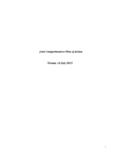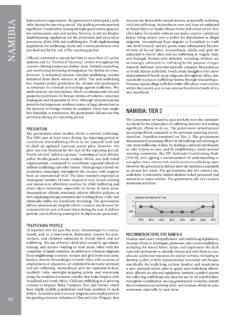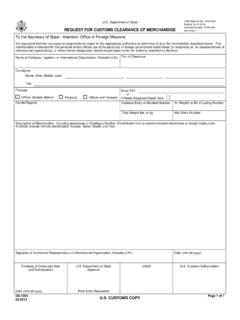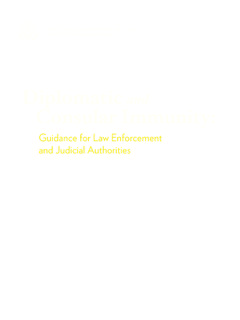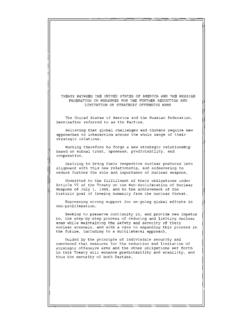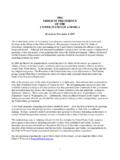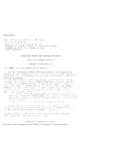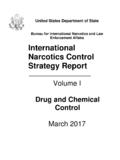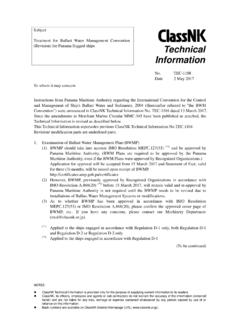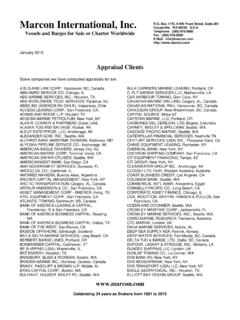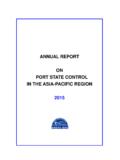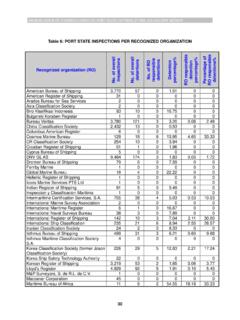Transcription of TABLE OF CONTENTS - State
1 2 TABLE OF CONTENTS Page Introduction 6 Identification of Excessive maritime Claims 7 Legal Division of the Ocean and Airspace 8 Historic Waters 8 Criteria 8 Foreign Waters Considered Not to be Historic 9 Argentina and Uruguay-Rio de la Plata 9 Cambodia and Vietnam-Gulf of Thailand 12 India and Sri Lanka-Gulf of Manaar, Palk Bay 13 Italy-Gulf of Taranto 13 Libya-Gulf of Sidra 16 Panama-Gulf of Panama 17 the Great Bay18 Passage19 Vietnam-Gulf of Tonkin 20 Baselines 20 Normal Baseline 20 Harbor Works 21 Reefs 21 Straight Baselines 21 Excessive Straight Baseline Claims 23 Canada 28 Costa Rica 31 Portugal 31 Territorial Sea 32 Contiguous Zone 39 Haiti 39 Namibia 39 Vietnam 40 Exclusive Economic Zone 40 The EEZ and the LOS Provisions 40 The EEZ and State Practice 42 3 Continental Shelf 45 Archipelagoes 48 Cape Verde 49 Philippines 49 Navigation and Overflight Rights 51 Right of Innocent Passage 51 Permissable Restrictions on Innocent Passage 52 Temporary Suspension of Innocent Passage 53 Excessive Restrictions on Innocent Passage 54 Time Limits for Passage and Prohibited Zones 55 Passage Limited to Sea Lanes 56
2 Prior Notice or Permission for Warship Innocent Passage 58 Enforcement of Violations 59 State Practice on Warship Innocent Passage 59 Other Restrictions on Innocent Passage 62 Yemen (Aden) 62 Yemen (Sanaa) 62 Pakistan 62 Djibouti 62 Egypt 62 Roll back of claims 62 Turkey 62 Soviet Union 63 International Straits 63 Legal Regime 63 Transit Passage 63 Innocent Passage 65 Navigation Regimes of Particular Straits 65 Aland Strait 65 Bab el Mandeb 66 Bosporus and Dardanelles 66 Gibraltar 66 Hormuz 67 Magellan 68 Messina 66 Northeast Passage 70 Northwest Passage 72 Oresund and The Belts 73 Strait of Tiran 74 Overflight Restrictions 75 4 Cuba 75 Ecuador 76 Libya 76 Peru 76 Archipelagic Sea Lanes Passage 76 Excessive Claims 76 Philipines 76 Annex I Presidential Proclamation 5030 78 Statement by the President 79 Annex II states Ratifying the United Nations Convention on the Law of the Sea 82 Annex III Uniform Interpretation of the Rules of International Law Governing Innocent Passage Through the
3 Territorial Sea 86 TABLES: 1 Claims Made to Historic Bays 10 2 Claims Made to Straight Baselines 25 3 Territorial Sea Claims 1958 and 1992 35 4 Territorial Sea Claims Greater than 12 Miles 36 5 Territorial Sea Claims that have been "Rolled Back" to 12 miles 37 GRAPHS: 1 Chronology of Territorial Sea Claims with Breadths exceeding 12 nautical miles 38 2 Chronology of Claims to the right to Control Entry of Warships into own Territorial Sea 61 MAPS: 1 Argentina and Uruguay Historic Water Claimto the Rio de la Plata 9 2 India- Sri Lanka 14 3 Italy's Historic Bay Claim: Gulf of Taranto 15 4 Libya's Restricted Navigation Areas 17 5 Peter the Great Bay 19 5 6 Burma: Straight Baselines Claim 24 7 Canadian Arctic Straight Baselines 30 8 FRG's Territorial Sea Extension in the North Sea 34 9 Soviet Bumping of Vessels in the Black Sea 57 10 Strait of Hormuz 68 11 Strait of Tiran 75 6 INTRODUCTION The purpose of this study is to publicize efforts undertaken by the United states Government to preserve and enhance navigation freedoms worldwide.
4 Particularly, this study will focus on the Freedom of Navigation (FON) Program, begun in 1979 and designed to be a peaceful exercise of the rights and freedoms of navigation and overflight recognized under international law. United states policy is to:1 accept and act in accordance with the balance of interests relating to traditional uses of the oceans--such as navigation and overflight. In this respect, the United states will recognize the rights of other states in the waters off their coasts, as reflected in the Convention, so long as the rights and freedoms of the United states and others under international law are recognized by such coastal states . In addition, United states policy is to: exercise and assert its navigation and overflight rights and freedoms on a worldwide basis in a manner that is consistent with the balance of interests reflected in the convention.
5 The United states will not, however, acquiesce in unilateral acts of other states designed to restrict the rights and freedoms of the international community in navigation and overflight and other related high seas uses. Under the FON Program the United states undertakes diplomatic action at several levels to preserve its rights under international law. It conducts bilateral consultations with many states stressing the need for and obligation of all states to adhere to customary international law, as reflected in the 1982 United Nations Convention on the Law of the Sea (LOS Convention).2 When appropriate, the United states delivers formal diplomatic protests addressing specific maritime claims that are inconsistent with international law.
6 Since 1948, the United states has filed more than 140 such protests, including more than 110 since the FON Program began. Portions of these notes are reprinted, or cited, in this study. Operations by naval and air forces designed to emphasize internationally recognized navigational rights and freedoms complement diplomatic efforts. These assertions of rights and freedoms tangibly exhibit determination not to acquiesce in excessive claims to maritime jurisdiction by other states . Although some operations receive public scrutiny (such as those that have occurred in the Black Sea and in the Gulf of Sidra), most do not. Since 1979, military ships and aircraft have exercised their rights and freedoms in all oceans against objectionable claims of more than 35 countries at the rate of some 30-40 per year.
7 Two caveats should be noted in regard to this study. First, it does not purport to discuss all 1 Statement on United states Oceans Policy, March 10, 1983, International Legal Materials, Vol. 22, p. 464; American Journal of International Law, Vol. 77, p. 619 (1983). See Annex I for the text of this Statement. 2 The Los Convention was concluded December 10, 1982, and will enter into force one year following the deposit of the 60th instrument of ratification with the United Nations. As of February 15, 1992, 51 states had deposited their instruments of ratification. See Annex II for a list of states that have ratified the Convention. 7 coastal State maritime claims that may be inconsistent with the law of the sea, nor does it set out all actions taken by the United states (and other states ) in response to these excessive claims.
8 Thus, the failure to mention a particular claim should not be construed as acceptance of that claim by the United states . Second, this paper does not attempt to identify the overwhelming practice of states which conforms to the provisions of the LOS Convention. Although the discussion which follows focuses on excessive claims, the fact remains that the general practice by states reflects acceptance as customary international law of the non-seabed parts of the LOS Convention. IDENTIFICATION OF EXCESSIVE maritime CLAIMS Claims by coastal states to sovereignty, sovereign rights, or jurisdiction over ocean areas that are inconsistent with the terms of the LOS Convention are, in this study, called "excessive maritime claims". They are illegal in international law. Since World War II, more than 80 coastal states have asserted various claims that threaten the rights of other states to use the oceans.
9 These excessive maritime claims include, but are not limited to, claims inconsistent with the legal division of the ocean and related airspace reflected in the LOS Convention, such as: - unrecognized historic water claims;- improperly drawn baselines for measuring maritime claims;- territorial sea claims greater than 12 miles;3 - other claims to jurisdiction over maritime areas in excess of 12 miles, such as security zones, that purport to restrict non-resource related high seas freedoms; - contiguous zone claims at variance with Article 33 of the LOS Convention;- exclusive economic zone (EEZ) claims inconsistent with Part V of the LOS Convention; - continental shelf claims not in conformance with Part VI of the LOS Convention; and - archipelagic claims inconsistent with Part IV of the LOS categories of excessive maritime claims include claims to restrict navigation and overflight rights reflected in the LOS Convention, such as: -territorial sea claims that impose impermissible restrictions on the innocent passage of military and commercial vessels, of ships owned or operated by a State and used only on government noncommercial service, and of nuclear-powered warships (NPW) or warships and naval auxiliaries carrying nuclear weapons or specific cargoes; 3 All miles in this study, unless otherwise noted, refer to nautical miles.
10 One nautical mile equals 1,852 meters. 8 - claims requiring advance notification or authorization for innocent passage of warships and naval auxiliaries through the territorial sea or EEZ or applying discriminatory requirements to such vessels; -territorial sea claims not exceeding 12 miles that overlap straits used for international navigation and do not permit transit passage, including submerged transit of submarines, overflight of military aircraft, and surface transit of warships and naval auxiliaries (including transit in a manner of deployment consistent with the security of the forces involved), without prior notification or authorization; and - archipelagic claims that do not permit archipelagic sea lanes passage, including submerged passage of submarines, overflight of military aircraft, and surface transit of warships and naval auxiliaries (including transit in manner of deployment consistent with the security of the forces involved), without prior notice of authorization.
